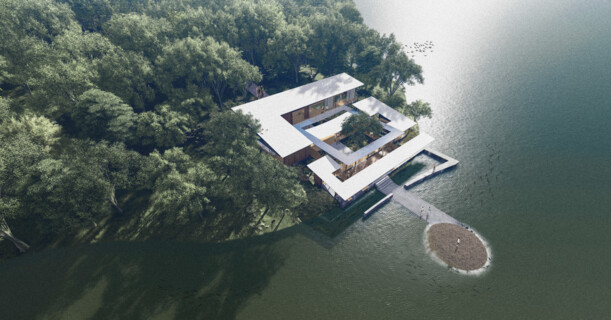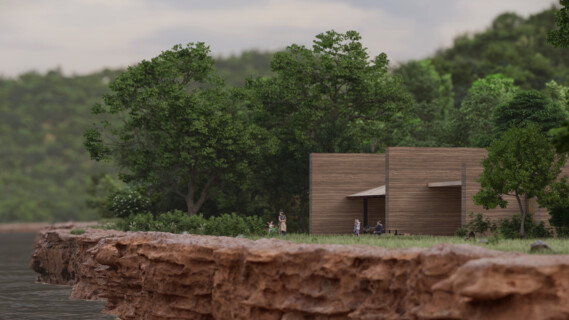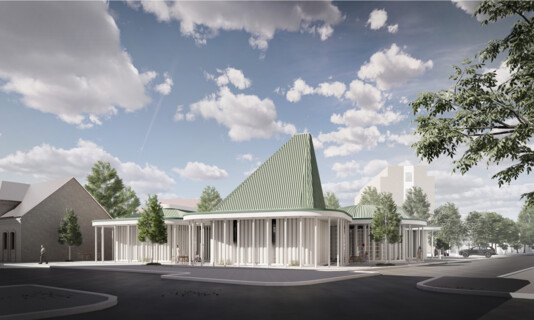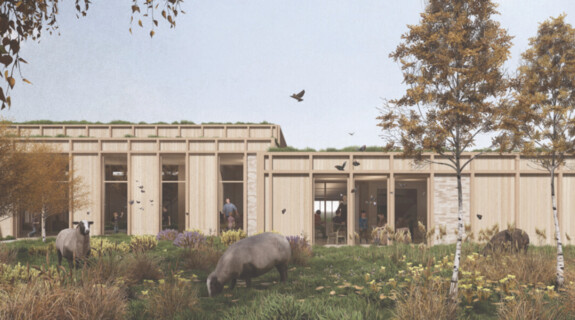- wa-ID
- wa-2035020
- Tag der Veröffentlichung
- 13.10.2022
- Aktualisiert am
- 23.06.2023
- Verfahrensart
- Offener Wettbewerb
- Zulassungsbereich
-
Andere
- Teilnehmer
- Keine Teilnahmebeschränkungen
- Auslober
- Buildner Architecture Competitions
- Bewerbungsschluss
- 06.04.2023
- Abgabetermin
- 05.05.2023
- Bekanntgabe
- 21.06.2023
Verfahrensart
Offener Ideenwettbewerb
Wettbewerbsaufgabe
Der Kampf gegen eine lebensbedrohliche Krankheit ist eine unglaublich schwierige Herausforderung, insbesondere für Kinder und ihre Familien. Es ist eine unmögliche Situation, die es zu bewältigen gilt, und eine Familie ist vielleicht nicht immer in der Lage, die nötige Unterstützung zu geben, egal wie sehr sie sich bemüht. Ärzte und Fachleute können die körperliche Gesundheit eines Kindes unterstützen, aber es braucht mehr als nur das, wenn es mit einer Krankheit zu kämpfen hat, ebenso wie seine Familie.
Der Architekturwettbewerb für das Children's Hospice ist der zweite in einer Reihe von Entwürfen für einen Ort, der Kindern und ihren Familien, die unheilbar krank sind, mehr Unterstützung bieten kann. Die Jury ist auf der Suche nach Entwürfen, die Kindern während ihres Kampfes gegen die Krankheit eine Pause, Erholung und Unterstützung in jeder Form bieten.
Das Kinderhospiz würde als Zentrum fungieren, das Kinder täglich besuchen können, um die Hilfe und Unterstützung zu erhalten, die sie während ihrer Behandlung benötigen. Dieser Wettbewerb bietet den Teilnehmern die Möglichkeit zu erforschen, wie Architektur als Hilfsmittel eingesetzt werden kann, um Menschen zu helfen, und zu zeigen, wie Architektur psychologische Erleichterung für die Leidenden bieten kann.
Obwohl es sich um einen Ideenwettbewerb handelt, bei dem der Schwerpunkt auf konzeptionellen Entwürfen liegt, muss das Kinderhospiz dennoch einige wesentliche Funktionen erfüllen. Es muss über einen Gemeinschaftsbereich mit einem Versammlungsraum, einem Spielzimmer, einer kleinen Bibliothek und einer Kapelle, eine Küche und einen Speisesaal sowie einen privaten Bereich verfügen, der als Schwesternzimmer und Therapieraum für psychologische Unterstützung dienen könnte.
Für diesen Wettbewerb ist kein bestimmter Ort festgelegt, und die Teilnehmer werden gebeten, einen theoretischen Standort in ihrem Heimatland zu wählen.
Competition assignment
Battling a life-threatening illness is an incredibly difficult challenge, especially for children and their families. It’s an impossible situation to get through, and a family may not always be able to give all the support that’s needed, no matter how much they try. Doctors and specialists can offer support for a child’s physical health, but they need more than just that when struggling with an illness, and so does their family.
The Children‘s Hospice architecture competition is the second in a series that looks to create designs for a place that can give more support to children and their families facing terminal illnesses. The jury are looking for designs that offer respite, recuperation and receive support in whatever form they may need it while they are battling their illness.
The Children’s Hospice would act as a center where children can visit daily to get whatever help and support they need while they’re going through treatment. This competition is a chance for participants to explore how architecture can be used as a tool to help people and demonstrate how architecture can offer psychological relief to those who are suffering.
While this is an architecture ideas competition with an emphasis on creating more conceptual designs, the Children’s Hospice would still need to provide a few essential functions. It will need to have a common area with a gathering room, games room, small library, and chapel; a kitchen and dining room, as well as a private area that could function as a nurse’s room and therapy room for psychological support.
There is no defined location chosen for this competition, and participants are requested to select a theoretical site from their own home country.
Jury
Alan Dunlop of Alan Dunlop Architects is an architect with a portfolio of award winning buildings including the internationally renowned Hazelwood School for children and young people who are dual sensory impaired: blind and deaf;
Rubén García Rubio is an architect and co-founder of studioVRA based in Zaragoza, Spain;
Arturo Mc Clean is Communications Manager and Architect at Barcelona-based Miralles Tagliabue EMBT which has completed such projects as Kálida Sant Pau Centre in Barcelona - a space of emotional, social and practical support for cancer patients, and part of the Maggie’s Centre Network;
Dr Nirit Pilosof is an architect and researcher exploring the intersection of Healthcare, Technology, and Architecture, and the Head of Research in Innovation and Transformation at Sheba Medical Centre in Israel, and a Faculty Member at the Coller School of Management at Tel Aviv University;
Rion Philbin is the founder and Creative Director of Berlin-based No So Studio and his projects include the Casa-mac project, a home in Italy for a blind woman;
Susanne Siepl-Coates was a member of the architecture faculty at Kansas State University for over thirty years, where her teaching focused on the exploration of the relationships between the built environment and human health/well-being;
Sonsoles Vela Navarro is an architect and co-founder of studioVRA based in Zaragoza, Spain, with 15 years of experience working alongside private clients and builders to develop architectural designs on residential, commercial and healthcare projects;
Steven Wright is a Principal at Perkins Eastman and a specialist in its healthcare practice;
Dr Johan van der Zwart is a researcher at the department of Science, Technology and Policy Studies of the University of Twente and an assistant professor of architecture and health at the NTNU Norwegian University of Science and Technology whose research focuses on the interaction between technology, people, process and place.
Weitere Informationen zu allen Gewinnern finden Sie unter /
More information about all winners can be found at:
architecturecompetitions.com/childrenshospice
Offener Ideenwettbewerb
Wettbewerbsaufgabe
Der Kampf gegen eine lebensbedrohliche Krankheit ist eine unglaublich schwierige Herausforderung, insbesondere für Kinder und ihre Familien. Es ist eine unmögliche Situation, die es zu bewältigen gilt, und eine Familie ist vielleicht nicht immer in der Lage, die nötige Unterstützung zu geben, egal wie sehr sie sich bemüht. Ärzte und Fachleute können die körperliche Gesundheit eines Kindes unterstützen, aber es braucht mehr als nur das, wenn es mit einer Krankheit zu kämpfen hat, ebenso wie seine Familie.
Der Architekturwettbewerb für das Children's Hospice ist der zweite in einer Reihe von Entwürfen für einen Ort, der Kindern und ihren Familien, die unheilbar krank sind, mehr Unterstützung bieten kann. Die Jury ist auf der Suche nach Entwürfen, die Kindern während ihres Kampfes gegen die Krankheit eine Pause, Erholung und Unterstützung in jeder Form bieten.
Das Kinderhospiz würde als Zentrum fungieren, das Kinder täglich besuchen können, um die Hilfe und Unterstützung zu erhalten, die sie während ihrer Behandlung benötigen. Dieser Wettbewerb bietet den Teilnehmern die Möglichkeit zu erforschen, wie Architektur als Hilfsmittel eingesetzt werden kann, um Menschen zu helfen, und zu zeigen, wie Architektur psychologische Erleichterung für die Leidenden bieten kann.
Obwohl es sich um einen Ideenwettbewerb handelt, bei dem der Schwerpunkt auf konzeptionellen Entwürfen liegt, muss das Kinderhospiz dennoch einige wesentliche Funktionen erfüllen. Es muss über einen Gemeinschaftsbereich mit einem Versammlungsraum, einem Spielzimmer, einer kleinen Bibliothek und einer Kapelle, eine Küche und einen Speisesaal sowie einen privaten Bereich verfügen, der als Schwesternzimmer und Therapieraum für psychologische Unterstützung dienen könnte.
Für diesen Wettbewerb ist kein bestimmter Ort festgelegt, und die Teilnehmer werden gebeten, einen theoretischen Standort in ihrem Heimatland zu wählen.
Competition assignment
Battling a life-threatening illness is an incredibly difficult challenge, especially for children and their families. It’s an impossible situation to get through, and a family may not always be able to give all the support that’s needed, no matter how much they try. Doctors and specialists can offer support for a child’s physical health, but they need more than just that when struggling with an illness, and so does their family.
The Children‘s Hospice architecture competition is the second in a series that looks to create designs for a place that can give more support to children and their families facing terminal illnesses. The jury are looking for designs that offer respite, recuperation and receive support in whatever form they may need it while they are battling their illness.
The Children’s Hospice would act as a center where children can visit daily to get whatever help and support they need while they’re going through treatment. This competition is a chance for participants to explore how architecture can be used as a tool to help people and demonstrate how architecture can offer psychological relief to those who are suffering.
While this is an architecture ideas competition with an emphasis on creating more conceptual designs, the Children’s Hospice would still need to provide a few essential functions. It will need to have a common area with a gathering room, games room, small library, and chapel; a kitchen and dining room, as well as a private area that could function as a nurse’s room and therapy room for psychological support.
There is no defined location chosen for this competition, and participants are requested to select a theoretical site from their own home country.
Jury
Alan Dunlop of Alan Dunlop Architects is an architect with a portfolio of award winning buildings including the internationally renowned Hazelwood School for children and young people who are dual sensory impaired: blind and deaf;
Rubén García Rubio is an architect and co-founder of studioVRA based in Zaragoza, Spain;
Arturo Mc Clean is Communications Manager and Architect at Barcelona-based Miralles Tagliabue EMBT which has completed such projects as Kálida Sant Pau Centre in Barcelona - a space of emotional, social and practical support for cancer patients, and part of the Maggie’s Centre Network;
Dr Nirit Pilosof is an architect and researcher exploring the intersection of Healthcare, Technology, and Architecture, and the Head of Research in Innovation and Transformation at Sheba Medical Centre in Israel, and a Faculty Member at the Coller School of Management at Tel Aviv University;
Rion Philbin is the founder and Creative Director of Berlin-based No So Studio and his projects include the Casa-mac project, a home in Italy for a blind woman;
Susanne Siepl-Coates was a member of the architecture faculty at Kansas State University for over thirty years, where her teaching focused on the exploration of the relationships between the built environment and human health/well-being;
Sonsoles Vela Navarro is an architect and co-founder of studioVRA based in Zaragoza, Spain, with 15 years of experience working alongside private clients and builders to develop architectural designs on residential, commercial and healthcare projects;
Steven Wright is a Principal at Perkins Eastman and a specialist in its healthcare practice;
Dr Johan van der Zwart is a researcher at the department of Science, Technology and Policy Studies of the University of Twente and an assistant professor of architecture and health at the NTNU Norwegian University of Science and Technology whose research focuses on the interaction between technology, people, process and place.
Weitere Informationen zu allen Gewinnern finden Sie unter /
More information about all winners can be found at:
architecturecompetitions.com/childrenshospice
CHILDREN‘S HOSPICE
Home for the Terminally ill / Edition #2
Organizers
Buildner Architecture Competition Organisers
About the Competition
Battling a life-threatening illness is an incredibly difficult challenge, especially for children and their families. It’s an impossible situation to get through, and a family may not always be able to give all the support that’s needed, no matter how much they try. Doctors and specialists can offer support for a child’s physical health, but they need more than just that when struggling with an illness, and so does their family.
The Children‘s Hospice architecture competition is the second in a series that looks to create designs for a place that can give more support to children and their families facing terminal illnesses. The jury are looking for designs that offer respite, recuperation and receive support in whatever form they may need it while they are battling their illness.
The Children’s Hospice would act as a center where children can visit daily to get whatever help and support they need while they’re going through treatment. This competition is a chance for participants to explore how architecture can be used as a tool to help people and demonstrate how architecture can offer psychological relief to those who are suffering.
While this is an architecture ideas competition with an emphasis on creating more conceptual designs, the Children’s Hospice would still need to provide a few essential functions. It will need to have a common area with a gathering room, games room, small library, and chapel; a kitchen and dining room, as well as a private area that could function as a nurse’s room and therapy room for psychological support.
There is no defined location chosen for this competition, and participants are requested to select a theoretical site from their own home country.
Eligibility
The competition is open to all. No professional qualification is required. Design proposals can be developed individually or by teams (4 team members maximum). Correspondence with organizers must be conducted in English; All information submitted by participants must be in English.
Schedule
Closing date for registration: 06 April 2023
Closing date for project submission: 05 May 2023 (11:59pm London Time)
Announcement of the winners: 21 June 2023
Prizes
Total Prize Fund: 7,000 €
1st Prize: 3,000 € + Publications + Certificate of Achievement
2nd Prize: 1,500 € + Publications + Certificate of Achievement
3rd Prize: 1,000 € + Publications + Certificate of Achievement
BUILDNER STUDENT AWARD: 1,000 € + 50 € ARCHHIVE BOOKS Gift Card + 50 Points BUILDNER Architecture University Rankings + Publications + Certificate of Achievement
BUILDNER SUSTAINABILITY AWARD: 500 € + Publications + Certificate of Achievement
+ 6 Honorable Mentions
More information and documents at


































